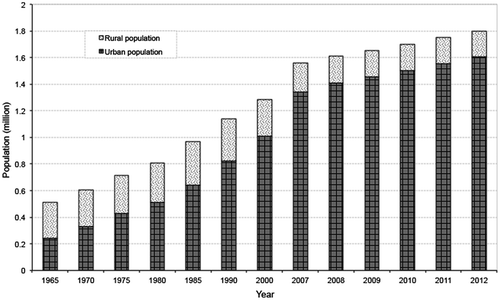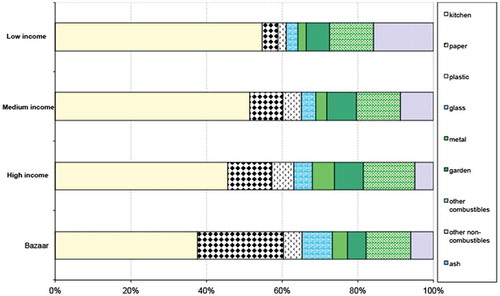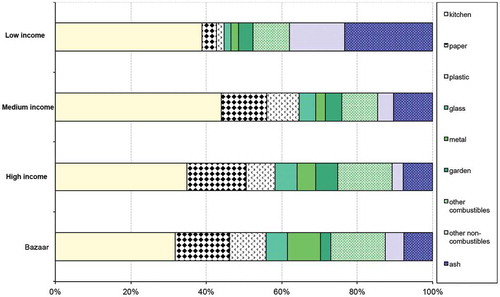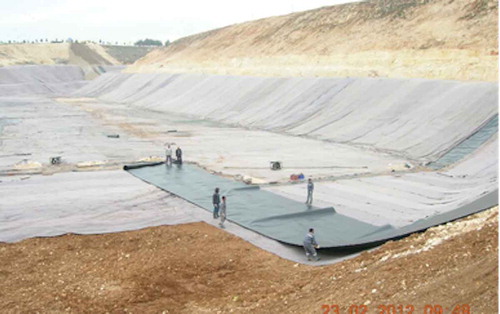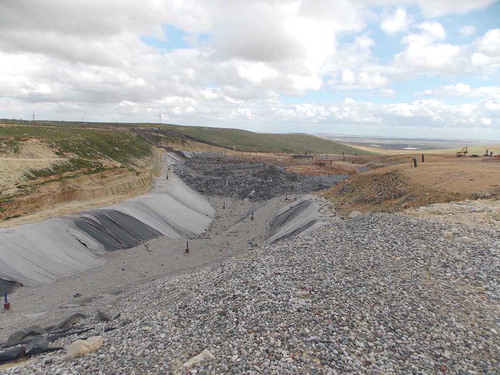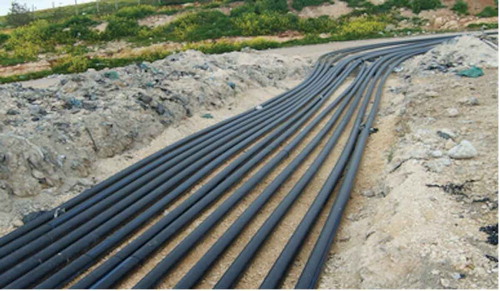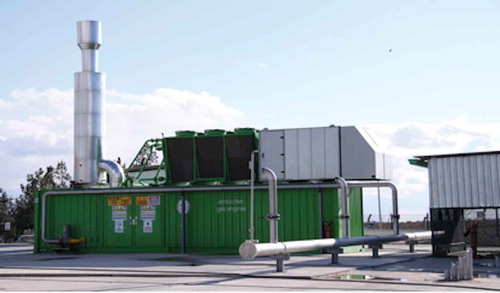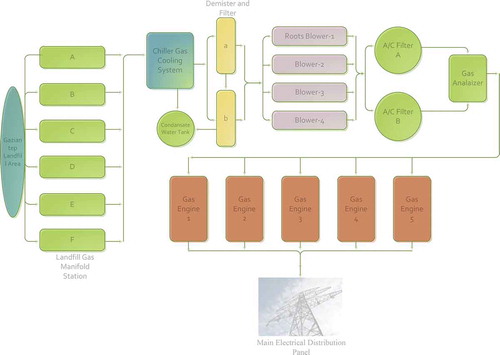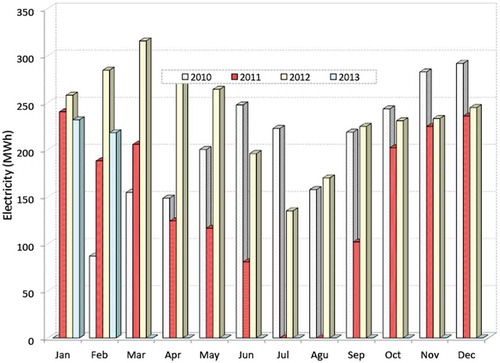Abstract
This paper presents an analysis of the electricity generation from municipal solid waste (MSW), via landfill gas valorization technology, at the landfill of Gaziantep City, Turkey. Rapid increase in population, and industrial developments, throughout the world including Turkey results in larger amount of waste materials generated, increased need for energy, and adverse affects on the environment and human health. Turkey plans to produce 1/3 of its electricity demand using renewable energy sources by the year of 2023. It is recommended to use each year around 25 million tonnes of the MSW generated nationwide for a renewable energy supply. In this study, a concise summary of current status of electricity generation from a MSW landfill gas plant (via biogas harnessing) located in Gaziantep City was analyzed as a case study.
Implıcatıons: MSW management has become a major challenge in Turkey, due to the increase in the amount of solid waste, which causes negative environmental impact and results in suboptimal use of raw materials and energy. An implication of waste-to-energy technology from MSW has been applied successfully in Gaziantep, where total MSW generated has increased steadily over last 15 years. The study showed the importance and benefit of energy recovery from MSW in both economic and environmental issues in Turkey.
Introduction
Municipal solid waste (MSW) management has become a major challenge throughout the world because the amount of solid waste produced has increased in many countries with high population and limited landfill areas. In 2006, 228, 219, and 619 million tonnes of MSW were generated in the 13 countries (Denmark, Finland, France, Germany, Greece, Italy, Ireland, Luxembourg, Netherlands, Portugal, Spain, Sweden, United Kingdom) of the European Union, in the United States, and in the Organisation for Economic Co-operation and Development (OECD) area, respectively (OECD, Citation2008). Although, less developed countries including China and India have relatively small amount of MSW, China is expected to generate around twice as much MSW as the USA, whereas India would overtake the USA by 2030 (East Asia and Pacific Urban Development Sector Unit [EASUR], 2005). Landfilling is a relatively simple and cheap technique for disposal of solid wastes. However, poor management of solid waste in landfill areas results in environmental (contamination of soil, water, and atmosphere) and human health impact, because of the leaching of toxic components from the solids wastes in landfill areas. Many researchers indicated a significant risk of birth defects and certain cancers for the population residing around landfill areas (Sever, Citation1997; Johnson, Citation1999; Rushton, Citation2003; World Health Organization [WHO], Citation2007; Giusti, Citation2009, Hoornweg and Bhada-Tata, Citation2012). Although the evidence of adverse health outcome, on a global scale, the main disposal method of billion (109) tonnes of MSW produced every year is still landfilling (DHV CR, Citation2001). Today, it is known that disposal of the MSW in landfill areas can be treated as a resource due to its high organic fraction and moderate energy content, which could be used for power generation (Consonni et al., Citation2005). Energetic MSW valorization strategies comprise incineration or production of a combustible fuel, including methane-rich landfill gas. Incineration, where the wastes are burned at high temperatures, is a relative old method. Alternatively, landfill gas containing methane and carbon dioxide produced by anaerobic digestion of MSW at the landfills can be harnessed for power generation. Landfill gas is collected using a system consisting of a number of wells drilled into the landfill and connected by a piping system. The landfill gas can be burned directly in a boiler as a heat-energy source, or it can be used in an internal combustion engine, or for electricity generation by gas turbines (Travis and Hattemer-Frey, Citation1989; McKay, Citation2002; Munster and Lund, Citation2010; U.S. Environmental Protection Agency [EPA], Citation2012; Rada, Citation2013; Rada et al., Citation2014).
Municipal solid waste (MSW) is an important environmental problem in Turkey due to the increase in population and rapid industrialization. Following the affirmation of the Kyoto Protocol of the United Nations Framework Convention on Climate Change (UNFCCC) by the Turkish Great National Assembly (TBMM, Turkish acronym) in 2009, environmental concerns have received much attention. A population of 78 million people in Turkey produce massive amount of MSW, which was 25 million tonnes in the year of 2010. It is estimated that MSW generation in Turkey will be around 29 million tonnes by the year of 2023 (Melikoglu, Citation2013). The MSW in Turkey usually consists of wastes collected in the same waste bins (Berkun et al., Citation2011). Traditional way of disposing MSW in Turkey has been open dump, where the solid wastes are simply dumped without any precautions (Kocasoy and Curi, Citation1995). However, more than half of the MSW disposal areas in Turkey is expected to be landfilling in next 10 years (Berkun et al., Citation2011). Actually, Turkey generates massive amounts of municipal solid waste, because of the rapid growing consumption trends accelerated by a growing affluence of working class. The country, as a member of G20 industrialized countries with a gross domestic product (GDP) around 1 trillion U.S. dollars, need colossal amounts of energy. Considering both the vast amounts of MSW generated and the country’s energy requirements, MSW can be used as a valuable energy source. Currently, less than 1% of energy contained in Turkish MSW is recovered country (Zamorano et al., Citation2007; Melikoglu, Citation2013).
In this study, the electricity generation via methane harnessing at the landfill of Gaziantep City in Turkey is investigated. Although there are some waste service deficiencies in many Turkish cities due to the lack of technical skills, financial resources, and management of municipality authorities (Turan et al., Citation2009), Gaziantep City has a modern solid waste disposal landfill with a well-established MSW management for two decades.
MSW Generation and Characteristics
The total MSW generated in Gaziantep City has increased steadily over last 15 years, from 129,000 tonnes in 1992 to 428,000 tonnes in 2011, which makes the MSW management in the city very crucial (). shows the monthly MSW generation in Gaziantep City between 1996 and 2011 (Hengirmen, Citation2012). Interestingly, a decrease in the amount of MSW was observed in 2008 and 2009. The authors consider that it could be because of the global financial crisis, which was accepted by many economists as the worst financial crisis since the 1930s (Altman, Citation2009). In Gaziantep, increased population, industrialization, and standards of living have contributed to an increasing amount of solid waste and its consequent disposal problems (Aydogan et al., Citation2011). The population was 0.5 million in 1965 and 1.8 million in 2012 (). In the 1960s, nearly 50% of the population was living in villages. However, in the last 50 years, Gaziantep transformed from an agricultural city to an industrialized city. Today, Gaziantep is a metropol with its economic structure, tourism potential, and metropolitan status. It is the center of highways and railways interconnecting the southeast of Anatolia to the west, Mediterranean, and Middle East. The population of Gaziantep is estimated to be 1.9 million by the year 2020 (Turkish Statistical Institute, TUIK). In 2007, 80% of the population in Gaziantep received sanitary waste service (Goren and Ozdemir, Citation2010). Before 1996, the MSW was transported out of the city and dumped in the open air without any restrictions. Waste disposal was not seen as a problem, so its management was just part of the routine work of the municipality. Nowadays, the MSW management is undertaken by Gaziantep Environmental Protection and Development Department, which is responsible for environmental monitoring at the final disposal and for material recovery. Information on the quantity of solid waste generated is fundamental to almost every aspects of solid waste management. Gaziantep’s wastes are generally classified into three major categories: (i) municipal solid wastes, (ii) industrial wastes including oil and battery, and (iii) medical wastes. However, the wastes in Gaziantep City are not usually sorted at the source, but collected in the same waste bins. Therefore, it is hard to know exact amount of recycling practiced in the city although it has been significantly increased since 1996.
Table 1. Municipal solid waste generation for Gaziantep City, between 1996 and 2011
A review of the research results involving the quantitative and composition analyses of the MSW in Gaziantep City in recent years was presented in the and for summer and winter seasons, respectively. The research was performed in four typical development areas in municipal surroundings: (i) housing for low-income inhabitants, who live in individual buildings, suburban, outskirts, single- and multifamily houses with coal-based heating systems; (ii) housing for medium-income inhabitants, who live in the city center, old and new buildings, combined heating systems (central and individual); (iii) housing for high-income inhabitants, who live in newly built housing estates with multifamily buildings with central heating systems; and (iv) bazaar, merchandising area, or street of shops where goods and services are sold. presents the results of the composition survey of Gaziantep City MSW in recent years’ summer season. During that period, considerable changes in the waste composition were observed:
Kitchen wastes prevailed in all areas including bazaar; however, most of it was found in the area where low-income inhabitants live.
The highest amount of paper was observed in the wastes collected from the bazaar.
The amount of other noncombustibles was highest in the waste from low-income inhabitant living area, and the lowest in high-income inhabitant living area.
The amount of multiple material waste including metal, garden, and glass was more comparable in all areas.
shows the MSW composition in Gaziantep in recent years’ winter season. The most striking point in this figure is a significant increase in the amount of ash, which might be attributed to the type of heating, particularly in the low-income housings. This study found that the main components of Gaziantep waste were food and paper, which constitute around 60% of overall weight in summer, whereas main components of Gaziantep wastes were food and ash in winter, constituting around 65% of overall weight in winter. These characteristics reflect the nature and lifestyle of the Gaziantep population.
Household solid wastes in the city of Gaziantep are transported by municipality-owned 6–20-m3-capacity trucks equipped with a hydraulic press. Metallic bins and containers are used to collect the municipal solid waste from the households. Typical bin sizes are 400 and 800 L. The local municipality supply containers and bins, and the residents are required to bring their solid waste into these bins within plastic waste bag supplied commercially. Solid waste recovery and recycling has been a longstanding commercial activity in Turkey (Neyim et al., Citation2001). With the recent investments in the recycling industry, almost all types of the plastic materials, glass, paper, and metals can be recycled at industrial levels. Despite certain limitations, in chosen districts of Gaziantep, residents collect packaging wastes such as glass, plastic bottles, cartons, and metal containers in the plastic bags/containers distributed to them by the municipality. The laborers sort them manually and compact them to reduce their size, and then they are sent to different factories to be reused and converted into useful products.
Landfill disposal area in the city of Gaziantep was an excavation with a lining system on its slopes and bottom that prevents the migration of leachate out of the landfill. The lining system consists of an impermeable, compacted clay at the bottom and geomembrane overlain by a permeable sand layer at the top (). The integrity of the liner system is very important. In the case of such composite lining systems, protecting a geomembrane from tearing during construction and after waste placement is critical. Actually, the geomembranes are subjected to heavy loadings. Therefore, sand layer as a protective cover is required for placement of materials over the geomembrane lining to prevent damage from construction loading, and to prevent overstressing of the geomembrane lining due to subsequent waste placement. shows the placement of waste over the protective cover system. Landfill gas is collected using a system consisting of a number of wells drilled into the landfill () and connected by a piping system (). The landfill gas is burned directly in a boiler as a heat-energy source for electricity generation by gas turbines ().
Electricity Generation from MSW
It is accepted that electricity consumption plays a crucial role in economic development of a country. Electricity consumption shows higher economic status of a country with a high gross domestic product (GDP) per capita (Jumbe, Citation2004). The most widely employed methods to estimate the electricity consumption for long-term energy demand are the autoregressive integrated moving average (ARIMA), the seasonal ARIMA (SARIMA), and the model for analysis of energy demand (MAED) (Ediger and Akar, Citation2007; Erdogdu, Citation2007). In this study, the approach proposed by Melikoglu (Citation2013) is used to estimate electricity consumption of Gaziantep City. Estimated electricity consumption for Gaziantep City is 8538 GWhr in the year of 2018, and 13,111 GWhr in 2023. The fact is that technical and economical feasibility of electricity generation from municipal solid waste either by combustion in mass burners or methane harnessing can be estimated in a city using electricity consumption data. Landfill gas valorization technologies are promising in terms of offering electricity and heat. Such an approach does not only diversify fuel but also mitigates the environmental pollution (Tsai and Kuo, Citation2010). Themelis and Ulloa (Citation2007) indicated that anaerobic biodegradation of one tonne MSW generates approximately 200 m3 methane gas, whereas 1 tonne industrial wastes generates a range of 40–80 m3. The maximum amount of generated methane during anaerobic decomposition of the organic content of MSW can be determined by eq 1 below.
Using the data shown in , and the methodology described by Themelis and Ulloa (Citation2007), it is estimated that 1 tonne of landfilled biomass in Gaziantep contains about 190–250 kg or 1.3–1.7 kmoles of organics (C6H10O4); hence, the reaction would generate about 4.2–5.5 kmoles or 67–88 kg methane. Melikoglu (Citation2013) estimated the methane production from the Gaziantep landfill to be around 43–56 million m3 in 2018 and 45–58 million m3 in 2023. Fisher (Citation1979) and Cuzin et al. (Citation1992) stated that the calorific value of methane is around 10 kWh/m3. Thus, assuming around 25% capture and 40% electric efficiency rates, the potential electricity generation from methane, which can be harnessed at the landfill of Gaziantep City, was calculated as 34–45 GWhr for 2018 and 36–46 GWhr for 2023.
Table 2. Average moisture and organic contents and calorific value of MSW in Turkey (Melikoglu, Citation2013)
shows the current flow diagram of electricity generation in Gaziantep landfill area. Total production was 2253 MWhr in the year of 2010, to be 1719 MWhr in 2011, and 2836 MWhr in 2012. Monthly base electricity production from the MSW collected in Gaziantep landfill is shown in . It can be seen that the amount of electricity generated was much lower through the summer as an overall view. The authors interpreted that this might be attributed to the reduction in moisture content (because of the evaporation) in the landfill area, which was required for the production of methane by anaerobic bacteria in the environment.
Conclusions
The paper reports an investigation carried out to indicate a landfill gas valorization technology from the MSW landfill in Turkey. The fact is that rapid population growth and economic development, lack of technical skills, infrastructure, and financial resources, and land scarcity make the management of municipal solid waste (MSW) become one of Turkey’s most critical environmental issues. Inadequate MSW treatment in Turkey has negative environmental impact and results in suboptimal use of raw materials and energy. Currently, energy recovery from MSW is less than 1% across the country, and immediate action should be taken by the government. In this study, a concise summary of current status of electricity generation from a MSW landfill gas plant (via biogas harnessing) located in Gaziantep City was analyzed. In Gaziantep, increased population (0.5 million in 1965 and 1.8 million in 2012), industrialization, and standards of living have contributed to an increasing amount of solid waste and its consequent disposal problems. The total MSW generated in Gaziantep City has increased steadily over last 15 years, from 129,000 tonnes in 1992 to 428,000 tonnes in 2011. A review of results of the research involving the quantitative and composition analyses of MSW in Gaziantep City indicated considerable changes in the waste composition for different seasons and inhabitants having various income levels. Total electricity production from the MSW collected in Gaziantep landfill can be further used as a reference work for the analysis of municipal solid waste investments in Turkey, and their environmental impacts. Consequently, the study showed the importance and benefit of energy recovery from the MSW in Gaziantep, Turkey.
Additional information
Notes on contributors
Safak Hengirmen Tercan
Safak Hengirmen Tercan is an Assistant Professor at the Hasan Kalyoncu University, Department of Civil Engineering.
Ali Firat Cabalar
Ali Firat Cabalar is an Associate Professor at the University of Gaziantep, Department of Civil Engineering.
Gokhan Yaman
Gokhan Yaman is an Environmental Engineer at Gaziantep Metropolitan Municipality, Department of Environmental Protection and Control.
References
- Altman, R.C. 2009. The great crash, 2008: A geopolitical setback for the west. Foreign Affairs 88:2–14.
- Aydogan, O., G. Varank, and M.S. Bilgili. 2011. Municipal solid waste management in Gaziantep. J. Eng. Nat. Sci. 3:268–275. doi:10.1016/j.wasman.2011.06.005
- Berkun, M., E. Aras, and T. Anilan. 2011. Solid waste management practices in Turkey. J. Mater. Cycles Waste Manag. 13:305–313. doi:10.1007/s10163-011-0028-7
- Consonni, S., M. Giugliano, and M. Grosso. 2005. Alternative strategies for energy recovery from municipal solid waste: Part B: Emission and cost estimates. Waste Manag. 25:137–148. doi:10.1016/j.wasman.2004.09.006
- Cuzin, N., J.L. Farinet, C. Segretain, and M. Labat. 1992. Methanogenic fermentation of cassava peel using a pilot plug flow digester. Bioresour. Technol. 41:259–264. doi:10.1016/0960-8524(92)90011-L
- DHV CR, 2001. Waste Management Policies in Central and Eastern European Countries: Current Policies and Trends. DHV CR Ltd., Prague, Czech Republic.
- EASUR, 2005. Waste Management in China: Issues and Recommendations. Urban Development Working Papers, East Asia Infrastructure Department, World Bank, Working Paper No. 9, East Asia and Pacific Urban Development Sector Unit (EASUR), May 2005.
- Ediger, V.S., and S. Akar. 2007. ARIMA forecasting of primary energy demand by fuel in Turkey. Energy Policy 35:1701–1708. doi:10.1016/j.enpol.2006.05.009
- Erdogdu, E. 2007. Electricity demand analysis using cointegration and ARIMA modelling: A case study of Turkey. Energy Policy 35:1129–1146. doi:10.1016/j.enpol.2006.02.013
- Fisher, S.T. 1979. Electrical induction heating: A new approach to underground coal gasification. Energy Convers. 19:77–84. doi:10.1016/0013-7480(79)90003-2
- Giusti, L. 2009. A review of waste management practices and their impact on human health. Waste Manag. 29:2227–2239. doi:10.1016/j.wasman.2009.03.028
- Goren, S., and F. Ozdemir. 2010. Regulation of waste and waste management in Turkey. Waste Manag. Res. 29:433–441. doi:10.1177/0734242X10378887
- Hengirmen, S. 2012. Cevre alanında finansman fırsatları. In Cevre Alanında Kapasite Gelistirme Projesi Yerel Cevre Eylem Planları Finansman Kaynakları Semineri, Ankara, Turkey. http://www.rec.org.tr/dyn_files/42/5100-4-Cevre-Alaninda-Finansman-Firsatlari.pdf (accessed October 20, 2014).
- Hoornweg, D., and P. Bhada-Tata. 2012. What A Waste, A Global Review of Solid Waste Management. Urban Development Series. Washington, DC: World Bank.
- Johnson, B.L. 1999. A review of the effects of hazardous waste on reproductive health. Am. J. Obstetr. Gynecol. 181:S12–S16. doi:10.1016/S0002-9378(99)70466-7
- Jumbe, C.B.L. 2004. Cointegration and causality between electricity consumption and GDP: Empirical evidence from Malawi. Energy Econ. 26:61–68. doi:10.1016/S0140-9883(03)00058-6
- Kocasoy, G., and K. Curi. 1995. The Umraniye-Hekimbas, open dump accident. Waste Manag. Res. 13:305–314. doi:10.1177/0734242X9501300402
- McKay, G. 2002. Dioxin characterisation, formation and minimisation during municipal solid waste (MSW) incineration: Review. Chem. Eng. J. 86:343–68. PII: S1385-8947(01)00228-5. doi:10.1016/S1385-8947(01)00228-5
- Melikoglu, M. 2013. Vision 2023: Assessing the feasibility of electricity and biogas production from municipal solid waste in Turkey. Renew. Sustain. Energy Rev. 19:52–63. doi:10.1016/j.rser.2012.11.017
- Munster, M., and H. Lund. 2010 Comparing waste-to-energy technologies by applying energy system analysis. Waste Manag. 30:1251–1263. doi:10.1016/j.wasman.2009.07.001
- Neyim, O.C., E. Metin, and A. Erozturk. 2001. Packing waste in Turkey, recovery implementations and recycling industry. In: Proceedings of the 2nd International Packaging Congress and Exhibition, Izmir, Turkey, May 30–June 1, 561. 182–195.
- Organisation for Economic Co-operation and Development (OECD). 2008. OECD Key Environmental Indicators 2008. Paris: OECD Environment Directorate, Organisation for Economic Co-operation and Development (OECD). http://www.oecd.org/env/ (accessed October 20, 2014).
- Rada, E.C. 2013. Effects of MSW selective collection on waste-to-energy strategies. WIT Trans. Ecol. Environ. 176:215–223. doi:10.2495/ESUS130181
- Rada, E.C., M. Ragazzi, G. Ionescu, G. Merler, F. Moedinger, M. Raboni, and V. Toretta. 2014. Municipal solid waste treatment by integrated solutions: Energy and environmental balances. Energy Procedia 50:1037–1044. doi:10.1016/j.egypro.2014.06.123
- Rushton, L. 2003. Health hazards and waste management. Br. Med. Bull. 68:183–197. doi:10.1093/bmb/ldg034
- Sever, L.E. 1997. Environmental contamination and health effects: What is the evidence? Toxicol. Ind. Health 13:145–161. doi:10.1177/074823379701300204
- Themelis, N.J., and P.A. Ulloa. 2007. Methane generation in landfills. Renew. Energy 32:1243–1257. doi:10.1016/j.renene.2006.04.020
- Travis, C.C., and H.A. Hattemer-Frey. 1989. Human exposure to dioxin from municipal solid waste incineration. Waste Manage. 9:151–156. doi:10.1016/0956-053X(89)90075-5
- Tsai, W.T., and K.C. Kuo. 2010. An analysis of power generation from municipal solid a waste (MSW) incineration plants in Taiwan. Energy 35:4824–4830. doi:10.1016/j.energy.2010.09.005
- Turan, N.G., S. Coruh, A. Akdemir, and O.N. Ergun. 2009. Municipal solid waste management strategies in Turkey. Waste Manag. 29:465–469. doi:10.1016/j.wasman.2008.06.004
- U.S. Environmental Protection Agency. Combustion 2012. http://www.epa.gov/osw/nonhaz/municipal/combustion.html (accessed October 20, 2014).
- World Health Organization (WHO). 2007. Population Health and Waste Management: Scientific Data and Policy Options. Report of a WHO Workshop, Rome, Italy, 29–30 March 2007. Rome: World Health Organization (WHO), European Centre for Environment and Health.
- Zamorano, M., P.P.J. Ignacio, P.I. Aguilar, and R. Ramos. 2007. Study of the energy potential of the biogas produced by an urban waste landfill in Southern Spain. Renew. Sustain. Energy Rev. 11:909–922. doi:10.1016/j.rser.2005.05.007


